#tropical geometry
Photo
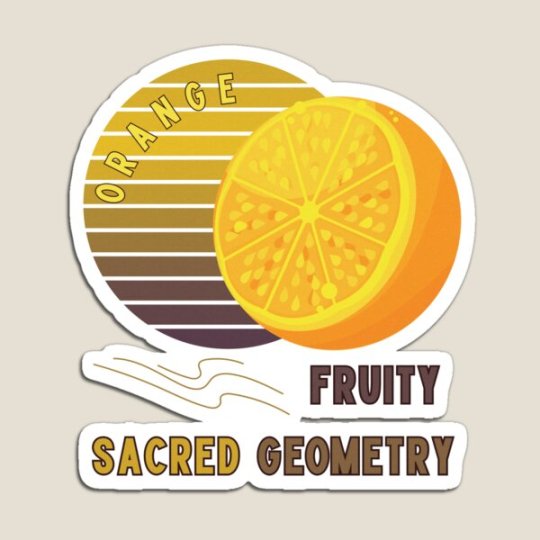

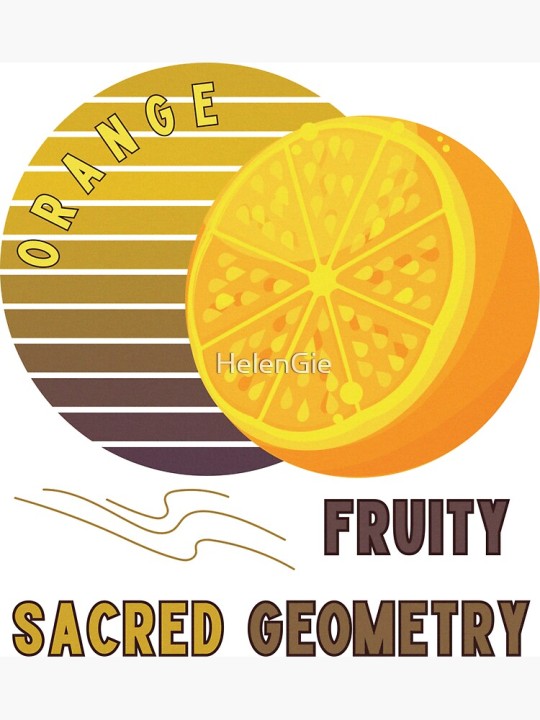
(via Orange Fruity Sacred Geometry Magnet by HelenGie)
#findyourthing#redbubble#magnet#cool fruit#tropical fruit#sacred geometry#vegan diet#vegetarian dishes#fruit art#vegetarianism#spiritualjourney#spiritual awareness
0 notes
Text


#forest aesthetic#earth#tropical#trees#forest#geometry#plants#sunlight#photography#nature#iphone photography#florida#orlando#botanical garden#botany
0 notes
Text
Tears of the Kingdom: The Final Analysis
Part 2
Picking up where we left off in Part 1, our next shot takes us to Hateno Village.

First and foremost, the mushrooms. ALL the mushrooms.

The mushroom umbrella is patterned with mushrooms, and the man in front of it looks to be wearing a mushroom hat.

Similarly, so is this girl with the broom. A mushroom emporium? Maybe a collector's thing, like golden bugs or gratitude crystals?

It looks as if they took over the Ventest Clothing Boutique; the shirt is patterned with mushrooms, and the flags now have mushroom hats of their own. For some context, here's the original:
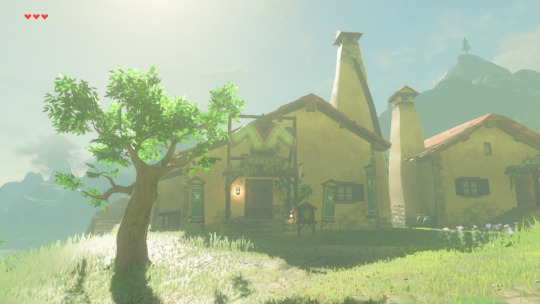
Purely speculatively, I think this might have some kind of gimmick outfit that you earn by hunting down rare mushrooms.
Moving on.

We've got a somewhat better look at the strange new towers, this one on top of one of the smaller peaks surrounding Mt. Lanayru.
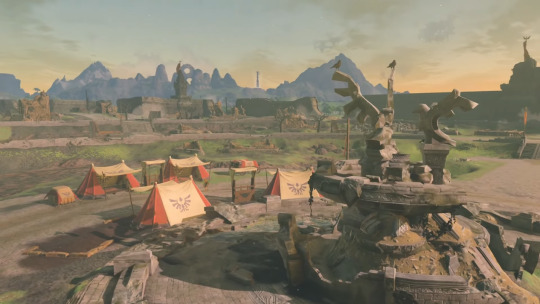
The next shot shows a camp in the ruins of Castle Town. All the malice and leftover guardian bits look like they've been removed.
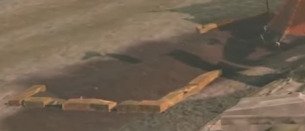
This bit here looks like a plot of land. Maybe a Tarrey Town situation, where you expand camps by bringing them supplies?

We can see a tower and the rock portal in the distance.

And Link is here in his green garb, meaning that whatever this camp is, the return of Ganon hasn't done anything to dissuade them.
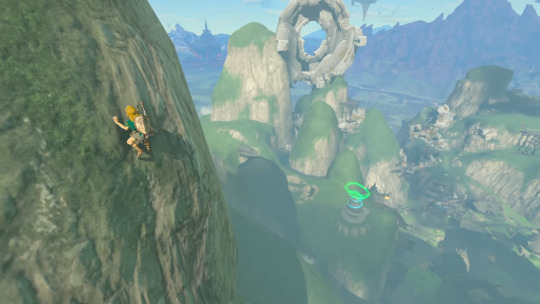
Link climbs up near the rock portal, and we get a better look at it, as well as the generator thing.
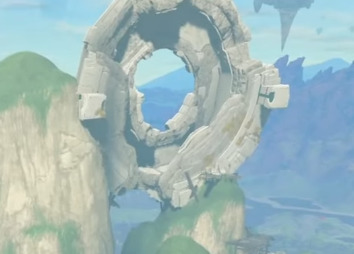
That is VERY deliberately made. Possibly a fallen ruin, but still, very portal-like.
The generator thing looks to have replaced Ta'loh Naeg Shrine
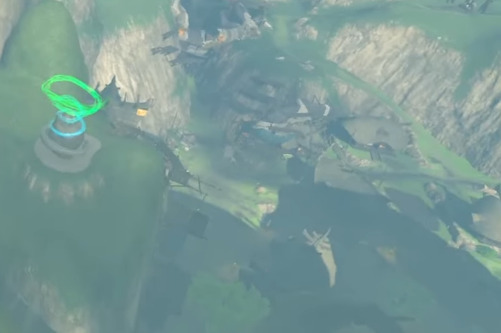
Because that down there is Kakariko Village.
EDIT: This is an error; I misinterpreted the angle of the town. Ta'loh Naeg is on the opposite cliff to this. Thanks @dracrownian!
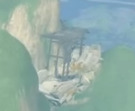
Also, this scaffolding looks to have been built AFTER the sky isles appear, because this one is built on a piece of ruin.

Hyrule Castle floats in the distance, but now we can see beneath it. It's hard to tell from this far away, but it LOOKS like it's hovering over a pool of malice.
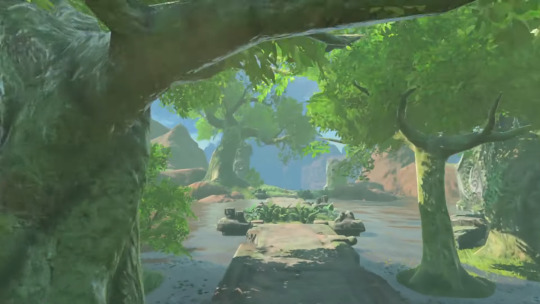
There's a quick shot through some trees

With some Zonai swirls off to the side

As well as some geometric shapes along the bridge. Between those and the ferns, I think this is near Faron Woods, but not in it, seeing as there are no tropical trees.
Edit: According to @fluffmugger, @priconstella, and @almostandrogynousdonut, this spot is actually up at Thyphlo Ruins!

And then this scene. Oh, this scene.

It took me awhile to find this geometry on the map. Especially with that spiral off to the right; most of them have correlated to where Shrines are, but this one doesn't. What clued me in was this bit here.

A bigger triangle-shaped rock with a small, short triangle beside it, slightly offset.
There's exactly one spot in Gerudo Desert that has these like this.

Southwest of Gerudo Town, right here. And there are two things of interest that stand in this area. The first, to the southwest, is the Gerudo Great Skeleton, which can just be made out here:

The second?

Arbiter's Grounds in Breath of the Wild was barely anything, just some vague pillars hinting at something-

-just beneath the surface.
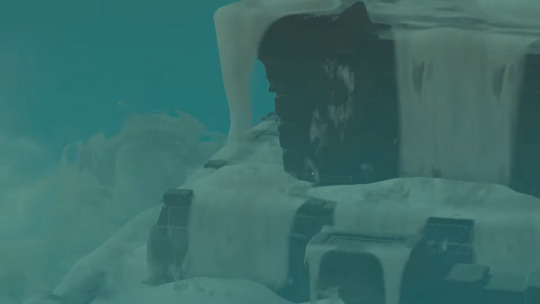
The BotW pillars don't quite match exactly. They're definitely not the torii-style gates above in the sky isles. But they ARE arches, over on the left, and the top squares of the pillars match the square bricks peeking out of the sand as the temple rises. It could be that the arches in BotW are what the beta version of Zonai arches looked like.

We then switch to the castle. Recall-able rocks plummet down around it, which indicates sky isles above.

Due to the sheer volume falling at once, I'm willing to believe that the rise of the castle is what directly causes the isles to show up.
Also

These are Sheikah at the forefront

And this looks to be some kind of logging camp or new settlement. There's a sign here that I imagine is meant to be interacted with at a later date.
And I've hit the picture limit, so when I finish Part 3, that link will be updated here.
Edit: Part 3!
147 notes
·
View notes
Text
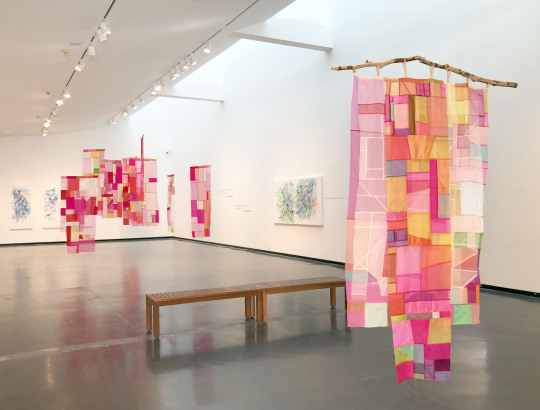
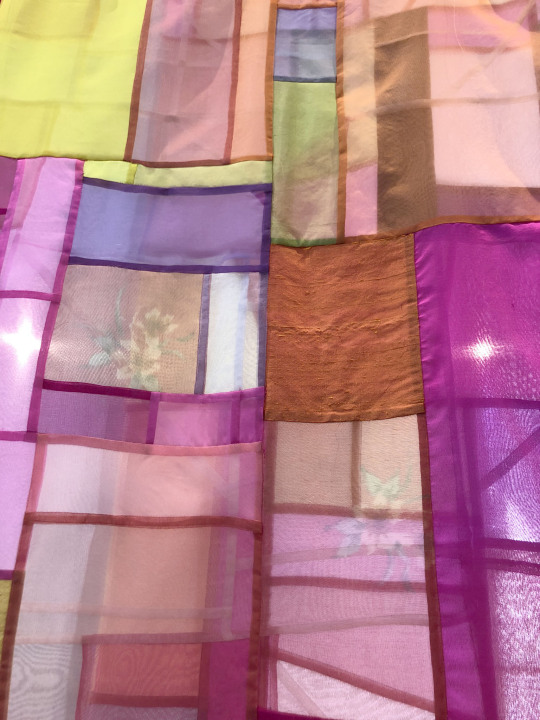

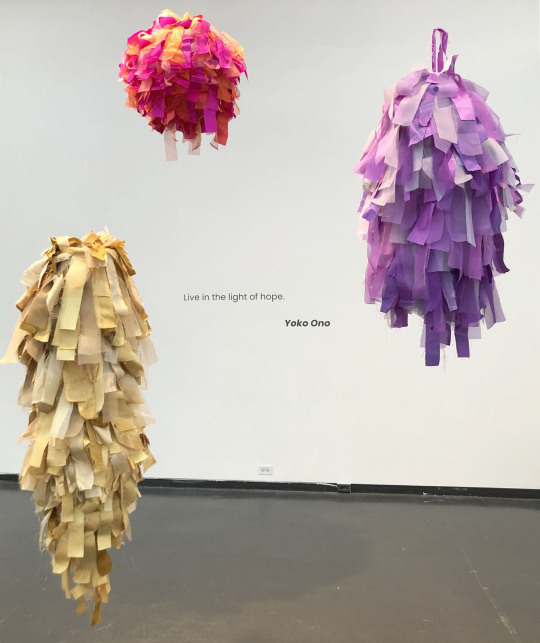

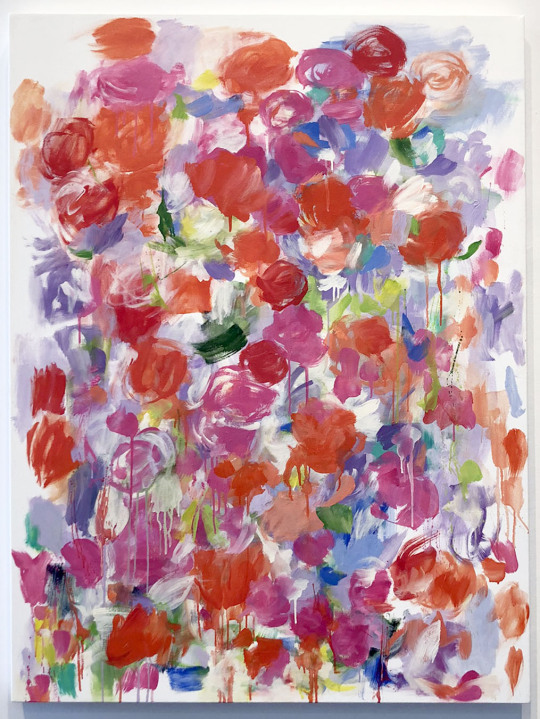

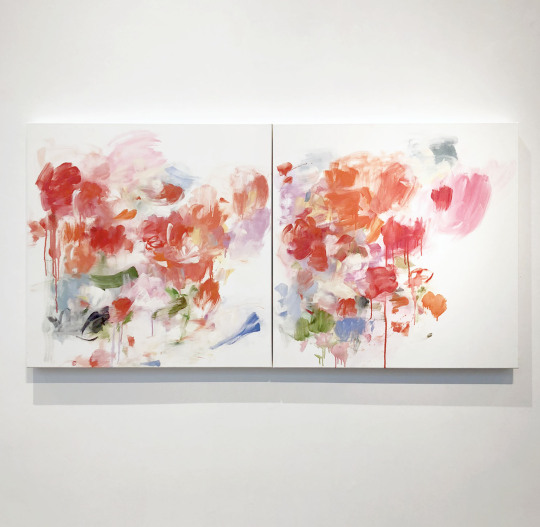
Currently at the Creative Pinellas gallery is Yolanda Sánchez’s Out of Eden, a collection of her paintings and textile work. The gallery is filled bright pleasing colors and this is the perfect exhibition to celebrate the spring season.
On the Creative Pinellas website, Sánchez discusses her work in a detailed essay. Below is a section of that piece.
Whether in painting or textiles, my working instruments are rhythm and color. I am interested in the joyful, playful or even spiritual properties of light. I am reflecting the light and color of where I live, of my immediate environment.
This artistic practice is improvisational and process-oriented, abstract. The relationship of one color to another creates a rhythm and tempo and establishes the composition. Each color suggests the next color, almost like the “call and response” form found in many musical traditions. There is a continuous orchestration, as the colors converse with one another, suggesting a mood or vibe.
I am often not sure where it is going or going to go. It is a surprise at every turn. I shape my perception as I work.
My textile work is informed by the Korean art form known as Bojagi. Humble in its origins, nameless women made these traditional textiles as often extravagant visual pieces using mundane, leftover fabric from wrapping, storing and transporting goods. Over time, the nobility introduced finer, more delicate cloth.
In its traditional form, design characteristics include stitching and seams to create linear elements, especially with translucent fabrics. These features differentiate and distinguish Bojagi from patchwork textiles found in other cultural traditions. Nevertheless, Bojagi shares what feminist art historians identify as centuries-old histories of turning scraps of fabric into beautiful objects and ultimately shifting perspectives from private to public.
I pay homage to these unknown women, authenticating their domestic work – and I affirm their values of inclusion, pleasure, love, the familial, the decorative, the colorful and joyful, the spiritual and the everyday.
My Bojagi-inspired textile work – painting with thread and fabric – honors the Korean tradition. Still, while relying on the conventions and basic structure, these pieces extend and interpret the Bojagi into a more contemporary form. I offer a new direction by varying medium and size and utilizing color compositions and stitching techniques less anchored to established methods.
Material, color, texture and transparency are crucial elements in this work, as is the geometry inherent in the design. While geometry, in this case, emerges from a particular culture, the form does not demand a specific culture-dependent response. Its only function is beauty. It is about the sensual delight derived from looking – the viewer can ascribe or chose meaning, if at all.
As an order, rhythm and pattern are generated within the geometry, creating beauty through harmony and stability, color dominates as a suggestive poetic force, concurrently evoking a connection to my immediate tropical environment. It sets as my intention arousing a sense of place, a feeling, and the atmosphere of an abstract garden, or even a walk through a field of flowers.
It is the color but also the sensuousness of nature that I endeavor to suggest in both my paintings and textiles.
This exhibition closes 4/16/23.
#yolanda sánchez#creative pinellas#florida art shows#art#art shows#bojagi#fabric art#painting#spring#pinellas county art#pinellas county art shows#sculpture#mixed media
40 notes
·
View notes
Text
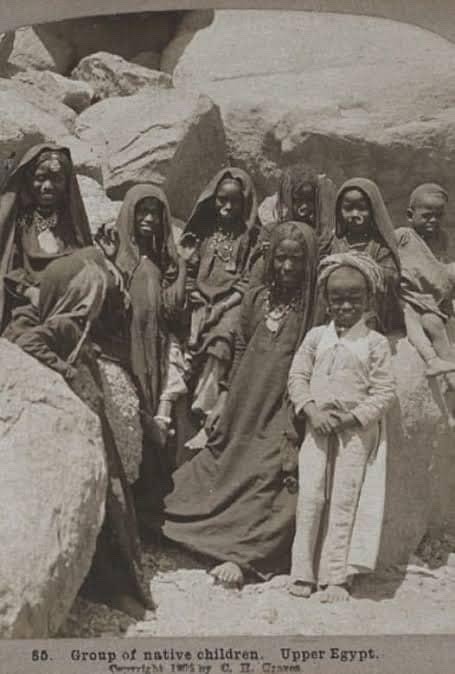









The indigenous peoples of the Hapi Valley were not Egytians or Nubians but rather Kemetyu and Nehesu, written in the Medu Neter as, 𓆎𓅓𓏏𓊖 and 𓅘𓎛𓋴 𓅫𓀎. They were sister civilizations with common culture and lineage in north east Africa. These ancient neolithic populations first migrated from the source of the Hapi which is in what European scholars love to call “Sub Sahran” Africa. It should be noted that this is a modern concept which these ancient populations did not adhere to.
The Source of the Blue Hapi being Lake Tana in Ethiopia and the White Hapi being Lake Victoria in Tanzania. Ta-Seti, Ta-Netjer and Ta-Meri evolved side by side, intermarried, traded, had alliances and conflicts. The Nation is Kemet, not Egypt and the region is Ta-Meri. In Medu Neter "Ta" means Land and Meri means Beloved (Beloved Land), and it was located in modern day Egypt and North Sudan. Ta-Netjer which is modern day Somalia and Northern Kenya translates to "Land of the Gods", Know as Punt of Puntland, indigenous known as Pwenet. Ta-Seti which is modern day Sudan translates to Land of the Bow, due to their world renowned Archers. They were masters of a style of archery known as "the double shot", which allowed them to fire two arrows almost simultaneously.
Narmer the first Pharaoh of Kemet was from Nehken which is modern day Aswan. He defeated the people of the Delta and Unified Upper and Lower Kemet. The people of Aswan today maintain their African identity as well as their dark Melanin.
Ta-Seti predates the unification of Ta-Meri known as Sema Tawy. Proof of this is the Qustul Burner which depicts Pharaonic iconography, a clear and concise artifact that proves Nwsts ruled in Ta-Seti in the Qustual and Naqada Regions around the same time if not before Menes came from the South and conquered the peoples who dwelled in the wet marshlands of the Delta. Menes came from the Nekhen, modern day Aswan, but his ancestors came from further south, down the Hapi river. He wore the white crown of Upper Kemet before the nation of Kemet was established, the same white crown depicted on the Qustul Incense Burner. These 3 civilizations, Ta-Meri, Ta-Seti, and Ta-Netjer comprised the Hapi Valley civilization.
The most clear-cut evidence of the origins of predynastic Kemetic culture is the 5,600 year old Black Mummy of the Green Sahara and the 9,000 year old Nabta Playa Stone Circle. This Black mummies remains was identified to belong to the A-Group, same as the cemeteries found in Qustual and Naqada. Also found was the earliest signs of cattle iconography and the worship or Het-Heru known later as Hathor, the Lady of Punt, or Pwenet. The Nabta Playa Stone Circle is one of the oldest astrological sites in the world. Adams Calendar which is located in South Africa being the oldest. At these sites they studied the procession of the equinox for thousands of years which allowed them to predict the monsoon seasons to grow their crops. Nabta Playa is also the site where humans first developed geometry and the concept of Pi. Around 3,400 BC drastic weather changes turned these luch tropical regions to desert and this is when these ancient Africans packed up and migrated northward following the flow of the Hapi river all the way to the Delta. These are the origins of Kemetic culture and science and the rest is history.
9 notes
·
View notes
Text
What is an algebraic variety?

The shape of the answers to equations.
Start with an equation like
Please take notice of three things:
the "+1" is used to shift the "zero line" or "answer line" up and down. So in fact "zero" is arbitrary.

This specific equation's left-hand side (which does not correspond to the picture; the picture is just supposed to be "an arbitrary continuous function") factors into
which factors into
I didn't specify what "x" is--it could belong to any coherent corpus of generalised "numbers" where "multiplicative identity" ("one") is meaningful
could be matrices, functional space, something I haven't thought of yet
tropical geometry. redefine "times" as ^ and "plus" as v
set theory union intersection
it is just a shorthand for
calculus 101. polynomials.
so not the price train of a narrowly-held company (all jumps)
fundamental theorem of algebra: Copf; is closed
as a mapping to zeroes
letting the LHS handle all the info (instead of x^2=16) is better organisation
affine -- geometric -- "forget the origin"

affine variety
kernel -- what's thrown in the trash. linear algebra.
intersections. system of equations. pretend a physical system. like going to the moon.
intersection. it has to solve all of them.
bezout's theorem.
the body
11 notes
·
View notes
Text
T.S.R. Shopping List 05/06/23 Part 6
Part 6 features creations by @christopher067, @sims4sue, @sunflower-petals, thanks for your work!
5 notes
·
View notes
Text
15 Questions | 15 People
There's no way I'm going to tag 15 people but I love this silly thingies. Thank you, @wanderingdonut ❤️
Are you named after anyone? Yup, after someone who did crazy things for love in the Middle Ages. Wicked, uh? And then my mom asks me why I'm like this: Lady, you named me after a tragic love story, it is what it is.
When was the last time you cried?: Uh, I don't remember, probably... Sunday? Lately I haven't been able to go a full week without crying, so, yeah, Sunday probably.
Do you have kids: A cat.
Do you use sarcasm a lot?: My default setting. That and snarky remarks, yeah, I'm such a sunshine.
What's the first thing you notice about people?: How they move. As a very nearsighted person, I learned to recognize people (close people, mainly, not everyone) by the way they walked. They have to be pretty fucking close for me to notice something else.
What's your eye colour?: Hazel. Very close to green when I cry (the magic of complementary colours) and very close to honey when it's sunny. Did you know that there's no word in Spanish for hazel eyes?
Scary movies or happy endings?: Psychological thrillers/Mysteries. I don't do well with scary scary movies. Also I love trying to guess what's really happening before the movie tells me (Ravenclaw, after all).
Any special talent?: Having a very above average good memory. And if I concentrate enough it will be a graphic memory. In school, when I studied hard, I could go back to the book in my mind and search to the pages until I found the answer. Don't know if that's a talent, tho.
Where were you born?: In a cold gray (and terracotta) city as well. But, funnily, in a tropical country. Most of the country is warm or even hot... But we are so fucking high so cold all year is what we have. Yay.
What are your hobbies?: You mean besides procrastinating and overthinking everything? Uhm. I supposed is reading, writing and sing songs really loud when I'm alone.
Do you have any pets? As I said: My pretty little gremlin.
which sports do you play/have you played?: There was a very odd time of my life where I craved camaraderie so much I ended in every team I could. I played with my school's football team (football as in British, soccer is a forbidden word in this blog), I was a cheerleader and then I played basketball. Didn't work for the making friends part but boy I was athletic at the time. I also did artistic skating, nice sport, expensive as hell. Then I started to swim as an sport (and not only as a way to not drown) in my final years of college and now that's the only thing I do.
How tall are you?: 1,67 m. We don't do inches in this house.
Favorite subject at school?: As the nerd I am, almost all. The one that was most interesting at the time. Literature, debate and social sciences (history, politics, etc) were always in the top 5. But there was a time when I was obsessed with chemistry, then probability and geometry (math) and biology was cool from time to time. As I said: A nerd.
Dream job?: Oh no, I don't dream about paid labour. I would like to be able to live comfortably spending my time reading, admiring beautiful things and trying not to kill my plants. Writing from time to time also. But no one is going to pay me a truly living wage for it so, yeah, I work in things.
Tags: uhm... I'm curious about @phoebe-delia and @propheciesanddreams. No pressure and I don't have any idea if you've been tagged before. Also, whoever want to: Come and steal it :)
4 notes
·
View notes
Text
3 A. pantherinoide edibles (2g each) + 10mg THC edible (report started on 7/26)
decided I was going to try last time's dose again. I wanted to get one more trip in before I move. intentions are the same as last time, as well as preparation. the dose was taken at 4:40pm. the only differences are that I did take my medicine this morning and, of course, the time.
6:18: all the effects came on at once surprisingly. it's a lot harder to understand what words mean, both with definition and sound. no visual effects that I can notice, but with my eyes closed I see simple geometry. I also find it harder to keep my eyes open and stay awake (effect of the delta-9)
6:56: starting to have difficulty typing. hallucinating that my hands have textures. an overlayed tranaparent mosiac eff3ct on top of swirls, in fact, the whole room is covered in swirls. having both open eye and closed eye geometry, albeit open eye is much weaker. my arms have a trail effect and I've been hearing a few seconds of rising tones once and awhile. this definitely all caught me off guard since I've never hallucinated this much before. none of it looks especially realistic, though. most of it is easily picked out. (post-trip note: all of the hallucinations I saw with my eyes open were faint or transparent)
7:06: my body feels like it's melting sway extremely slowly. the fact that I had to remind myself that I'm not actually melting because I felt anxious after thinking it is a little funny. the rest of this report will be written from the post-trip perspective. (post-trip note: the melting feeling felt like I was made of wax, with an empty outline of my body and my bones being the only thing left behind. I'm honestly not sure if this was an ego death, it might've been. this trip definitely didn't take place in the physical world and my body just felt like a border between what I was experiencing and this plane of reality. hard to explain.)
the peak of the trip was about an hour with the comedown and after effects lasting until I went to bed around 10pm. I decided to just close my eyes and let the trip play out rather than interrupt it every few minutes to type (which was already difficult). when I did open my eyes a few times I saw after images of my curtains and windows (curtains were red/blue, window was blue/yellow.) and tropical flowers growing on the ceiling, the inner petals were orange and the outer petals were purple. they were growing on a vine and grew and wilted extremely quickly, with them only lasting a few seconds. the longer I struggled with keeping my eyes open, the more the ceiling shifted and became the same square of patterning reflecting and changing. I closed my eyes again and watched the fractals and symmetrical patterns for awhile. I have a common theme of meeting "angels" (not by standard definition. it's complicated). I started by asking them if I could see what the afterlife is like and promised that I would only remember things they were okay with me remembering. before going to their realm we passed through a library, which I recognized as the place where the akashic records were kept (i.e the place where the records of everything to ever happen in the universe was kept). I asked if I could read the records during my short visit, but they told me I couldn't while I was visiting, which was fine. I kind of understood why I couldn't, seeing as I was merely paying a visit and not staying. plus, there were still some aspects of the human mind's limitations that stuck with me during my visit, so I don't think it would have been decipherable if I had been able to read any records. the first angel I met after passing through the library was one named "weatherboy". I don't remember much about him, other than his gold outlines and friendliness. everyone I met was so unique and all had their own personalities and appearances, some even had a specific way of communicating. one communicated with chiptune-esque chirps and beeps, while also saying both parts of the conversation. another communicated through sounds, one through taste and one of them even talked through time, specifically talking in the past. it's very hard to describe but it was all understandable to me. there were a few that especially stuck out to me, the angel of fun, the angel of art/music, and one named fiona. I also met a cherub who had 1 husy head in the middle, a wolf head to the left and a goat head to the right. their appearance was very cartoonish, their voices even more so, the dog in the middle had a brooklyn accent and sounded familiar, but I couldn't make out why. the cherub was probably the one I talked to most since we spent so long trying to figure out what character they sounded like. at some point I had asked someone if god exists, and they said something along the lines of "nah, god isn't real. but we are! even though each of us has their own personality, we all exist as one,". I was happy to hear it. I can't rememeber any specifics after that. towards the end of my visit, I let them know thay I was ready to go back. everyone told me they loved me and to take care of this life, apaprently this is my first incarnation. I very specifically remember all the angels I met saying "goodbye! we love you calvin!". at first this struck me as odd since "calvin" was only my name in this life, but thinking about it more afterward, it was a very sweet gesture of love and acceptance. after returning to my body, I found my head clearing and focus returning, which marked the comedown.
this trip really sticks out to me, since it was my first time having actual visuals, experiencing an ego death and possibly breaking through and talking to entities all in one trip. it makes me wonder what trips will be like once my p. cubensis start fruiting :] here's some doodles I did of both my avatar and some angels I met

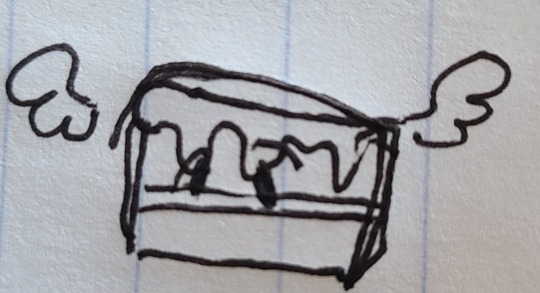
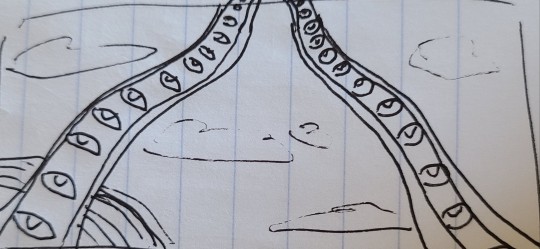
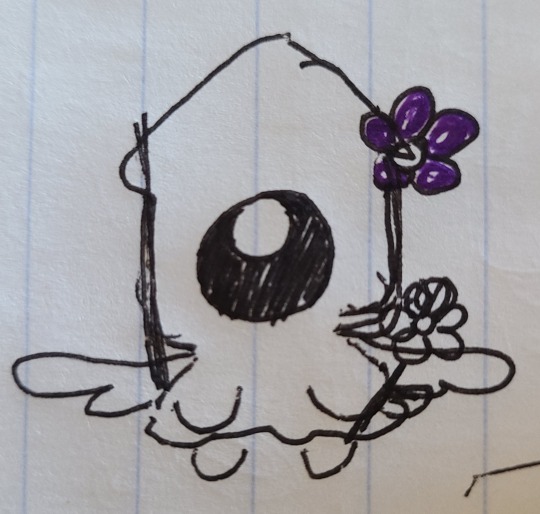
1 note
·
View note
Photo
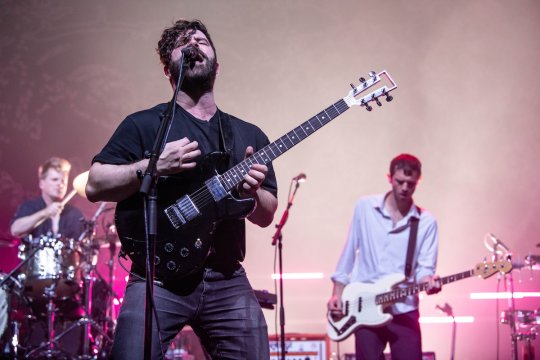

At the Anthem, an electric look back by British indie band Foals
Review by Teta Alim | December 14, 2022 at 2:33 p.m. EST | Washington Post
As Foals frontman Yannis Philippakis’s breathy singing sauntered behind the sound of waves and a somber melody at the start of 2010’s “Spanish Sahara” on Tuesday night at the Anthem, a memory of the British rock band from a past era washed ashore.
It was June 2013 in New York City. A tropical storm left Randall’s Island, the site of that year’s Governors Ball Music Festival, a muddy mess. But on the final day of the festival, a bright sky served as a picturesque backdrop for Philippakis’s crowd-surfing antics. At that point, Foals had released its third album, “Holy Fire,” leading its sharply intersecting guitars and tectonic drums to wide-open festival-ready fields. Grouped with Arctic Monkeys and Sky Ferreira, Foals became part of an aesthetic and musical era that today’s casual internet historians have dubbed “indie sleaze.”
After losing two founding members in recent years, the band is now a trio: Philippakis, drummer Jack Bevan and guitarist Jimmy Smith. Foals’ seventh and latest album, “Life Is Yours,” is an over-the-shoulder glance at the swirling pulses of its 2008 debut, “Antidotes,” but this time with less geometry and more funk-aspiring fizzy pop.
Though Foals albums can sometimes feel like the fossilized amber of an early 2010s rock soundscape, live performances invigorate the band and serve as its best context. “For me, the very core of being a musician isn’t sitting around in a studio. It’s performing and connecting with people,” Philippakis told the Guardian this year.
His showmanship at the D.C. concert was more understated, though he still strolled off the stage to get closer to the audience. He wore his performing experience well, which stood out after the two opening acts seemed to fade under the bright lights.
Foals transformed into a six-piece band onstage, with deft touring support, opening its set with the espresso shot of “Wake Me Up,” from “Life Is Yours.” The band’s newer songs, such as the prowling “2001” and delirious “2am,” stretched as empty-headed dance tunes, were anchored by Philippakis’s lively delivery.
Still, it was with its older material that Foals seemed most electric. When the guitars could finally chase each other through the blistering curls of Bevan’s drumming, as in the disquieted “Black Gold” and intricate “Two Steps, Twice,” it clicked why the band has endured nearly two decades after its formation. And Foals will continue its worldwide touring into 2023, partly with fellow music veterans Paramore and Bloc Party.
4 notes
·
View notes
Text
I will never say Splatoon 3 is a dissapointment, because it is far from that. Sure, there are some weird design choices that I don't really agree with, but it's such an improvement from the previous two overall. however, there's one feature that the developers teased since the very beginning that makes me feel, for lack of a better word. Cheated.
Shortly after the Splatoon 3 announcement trailer went live at the end of Febuary 2021's Nintendo Direct, the official SplatoonJP Twitter account posted various bits of information that weren't brought up during said Direct. One thing that stuck out in my mind was what they said about stages; the SRL said that the Inklings and Octolings would be fighting in the wilderness now. I, personally, was SO flipping excited.
Many, MANY people, however, weren't as pleased as I was upon reading this, predicting that all of the new stages were going to be a complete snoozefest in the aesthetics department, which. Does not make sense to me. Like, at all. Infact, once September of that same year rolled around, everyone breathed a sigh of relief upon spotting that two stages in the city were returning. Flash forward to 2022-23 and we've gotten stages primarily set in a city/town environment. The "fighting out in the wild" idea was SUCH a missed opportunity and, slightly contradicting what I said at the start of this post, I still feel incredibly dissapointed they kinda forgot about this idea.
So...why exactly do *I* think this would've been a great idea?
Getting this one out of the way, it would've added onto the many things that make this game stick out compared to its predecessors.
If the lore of the city is as interesting as it is now, imagine how many more details we could get about the outskirts of town.
...Yeah, that's about it. HOWEVER, here's my counter-argument to the "it would've been boring" take, using one of my favorite games ever, Super Mario Sunshine, as an example. Every single playable location in Super Mario Sunshine takes place on a tropical island setting. Every single area. To those who've never seen or played the game, most would say it sounds kinda boring. Let's take a gander at the areas in question.
An airstrip with waterpumps and crates scattered about, with a tall airport building scraping the sky.
A grassy windmill village separated into two halves with one large windmill putting it all together.
A harbor littered with colorful boats, grates, and buildings, the district area even putting together a seafood market.
An oceanside with a spire of light and a smoothie bar.
An amusement park with cartoony boat rides and ferris wheels.
A bay with large cliff faces engraved with massive shell statues and historic runes
A haunted hotel that, despite being cramped and small, has a massive labyrinth of rooms connected in very specific ways.
A festival loving exotic village above a deep chasm held together with massive trees.
All of which are interconnected via a humble town filled with fruitstands, shop buildings, fountains, boats, statues, and a massive shrine in the center.
Did I mention that, in every single one of these areas, you can spot the other levels in the background?
Splatoon already has something similar, albeit slightly more linear. You can spot some stage geometry in the background of a few stages, as well as every stage having its own unique lore. C'mon, the lord of the lake? It also has a similar idea of taking one general setting and ripping it up into seperate pieces. Every stage is in a city, but each location in the city is very unique. A warehouse, a parking garage, a port, a depot, a garbage dump, a shopping mall, a skatepark, a grocery store, I could go on. So, tell me...why would this idea suddenly be boring if the same was done with a more earthy, wilderness-like setting?
As of writing this post, Splatoon 3 is still getting updates, adding new stages and the like. So far, the only stages we've seen outside a city/town setting are Scorch Gorge, and a currently unnamed desert ruins stage, both of which still having some form of connection to city life.
I'm really hoping we get more stages with the wilderness idea in mind. I cannot express just how much of a missed opportunity this is.
#i was going to just make a short twitter thread and bring this up to a couple of friends on a discord call or something#but i really wanted to jot this down somewhere more in depth because#it means a whole lot to me#splatoon#splatoon 3#nintendo#super mario sunshine#mario sunshine
6 notes
·
View notes
Text
Ultimately I don't think that I am going to get a lot out of the book that I am reading about astrology but the author just went into a whole stretch of explaining the difference between Tropical and Sidereal astrology as well as a few words on Ophiuchus (the so-called thirteenth sign...) and it was so well written that I DEFINITELY understand it better now.
Additionally, it was like the author was explaining to me why I was drawn to astrology in the first place. Focus on the seasons, check. Orderliness, check. Weird obsession with numerology and geometry, check.
This is why it's always good to return to the so-called basics because your current level of understanding will definitely play a role in your absorption of the material.
#witchblr#words#nine#personal#astrology#sidereal astrology#tropical astrology#I won't even give the so-called thirteenth sign the cred of a tag here#that's some weird BS woo
15 notes
·
View notes
Text
Things I ate between the hours of 7pm yesterday and 5pm today:
1 apple
2 French toast stick
15mg of Lexapro
Second hand tropical punch vape smog from first period geometry
Shit (fell during PE)
0 notes
Text
The Quality of Light
Sarah got out of bed and gazed at the early light, a world blanketed in winter quiet, snowdrifts. Two more feet of snow had accumulated overnight. She put on her robe and slippers and watched the steady, gentle fall of the large, fluffy flakes. The muted yellows and pinks of the coming sunrise bathed the snowdrifts in ethereal light. She had always said that she missed these snowfalls but now that she was back home in the mountains, she dreaded going out in it. Somehow, she seemed too old and too heavy for the journey.
“How are you feeling?” her brother George asked.
“Disconnected,” she replied.
“It’s going to take a few days. You’ve come in on the tail end of things.”
Yes, she thought to herself, always coming in on the tail end of things. Since leaving home, her life had been nomadic – by choice. Exploration had always been her first love. Sometimes, she thought, it was her only love. Here she was, on the cusp of retirement, with nothing to show for her life except a head full of memories of places and people she had encountered. That wasn’t exactly true. She had thousands of photographs. But the art of photography, like all of the arts, was never the preferred currency in the transactional modern world.
“When does Max’s plane arrive?” she asked.
“Noon,” George replied. “He’s bringing Anna.”
“Wow. That’s a surprise.”
“Death has a way of, I don’t know, making us see what is important.”
“I guess so. Although I really don’t know why Anna hated Mom so much.”
“Second wife syndrome.”
“What do you mean?”
“Anna thinks that Mom never liked her.”
“Why does she think that? I never heard Mom say anything like that.”
“Because of the grandkids.”
Max had three now-grown children, all boys, and an ex-wife with whom he had had a very contentious divorce. Sarah had never asked Max about what had happened. Sharing feelings wasn’t part of the family dynamic. Keeping things bottled up was the preferred practice. But her mother had once commented on the situation. She had said, “His wife needs a lot more attention than most women. She’s not independent, like you. She thought she’d be that wife standing in the doorway with a martini in her hand, awaiting her man. She wanted his admiration. Veneration, maybe. And Max, well, he’s not the kind that dotes. She needs a doter.”
“I should venture outside,” Sarah said. “I love the quality of the light at this time of day.”
“Be careful,” George said. “It’s barely above zero out there.”
“I remember,” she said.
Sarah suited up for the cold, a procedure that reminded her of her youth, when they would use rope pulls to get to the tops of local hills, snowboarding or sledding all day long. The cold never really got to them when they were having fun.
Base layers. Extra socks. Gortex. She was ready. She decided not to bother with her camera equipment. The camera phone would do.
Beyond the front porch was a stand of sumac trees, which had sprung up suddenly after her father had passed. He would have ripped them out as soon they had appeared in his garden. But she loved the geometry of the sumacs, their gentle curves topped with those little red pyramids. They looked almost tropical against the straight, sturdy trunks of the aspens and birches.
Sarah loved the way that the snow interacted with the sumacs, their tufts of rust-colored seed pods now capped with white snow hats. The birds that braved winter subsisted on sumac and grass seeds. She had forgotten the joy of seeing bright red cardinals flitting about against the white of the snow.
There were no cardinals this morning. The snow had stopped falling and the pinks and oranges of the sunrise gave the snow drifts magical swathes of color, with the sumac casting faint, sinuous shadows. As she wandered through the thigh-deep snow, her memories cast their own shadows. She had chosen art school over university. She had chosen fine arts instead of business. She had chosen photography over graphic design. Analog over digital. They had been hers. Decisions. She owned them, but little else.
George had paid for her flight from Vancouver to Albany. She wouldn’t have been able to afford the trip otherwise. She didn’t have to ask. He knew. And that bothered her. She pushed the thought aside as she snapped a photo of a silver birch that seemed to blush with the dawn.
“How was it?” George asked when she returned to the house.
“Brisk,” she replied. “Thirty minutes is the limit for me today.”
“Here,” George said as he handed her a cup. “Hot cocoa.”
She smiled and held the cup close to her face, drinking in the aroma.
“This reminds me of Newburgh,” she said.
George chuckled. “Do you remember that time we were walking to school in a snowstorm, and you started to cry because your feet got cold?”
“Oh, yeah,” she replied. “It was painful. Mom didn’t even yell at us when we came back home.”
“That’s because you were crying. You always got your way when you cried.”
“I did?” she asked. “I don’t remember that.”
“It seemed that way to me,” he said. “Like when you had nightmares about going to hell and Mom and Dad took you out of catechism.”
“Oh, god, I do remember that. Sister Mary Margaret. She was horrible. Absolutely soulless. I think that’s the reason they took me out. They put me back in when she was removed.”
“She was old and senile,” he said.
“She scared the hell out of me. Well, actually she put the fear into me. Do you know what she said to us? She said, ‘You’re all destined for hell, especially you girls, you naughty, nasty little girls.’ Can you imagine? What a horrid thing to say to a child. And you wonder why so many people are in therapy.”
“Mom made cocoa for us that day,” he said.
Sarah nodded. “She did.”
Reflection overtook them as they sipped at their cocoa. Loss gripped Sarah’s heart and held it, making it hard for her to breathe. After a few sips, the loss overwhelmed her, and she burst into tears.
“I’m sorry,” she said through the tears. “I know you hate it when I cry. just feel so lost. I don’t know what to do. I feel so alone now that Mom is gone.”
George stood up and put his hand on her shoulder, giving her a gentle push. “I know.”
“I guess I’m finally having that midlife crisis that everyone talks about.”
“Don’t buy a red sports car,” he said. “It’s a dead giveaway that you’re not handling your age well.”
She chuckled and wiped at her tears. “I really do hate crying. I get a sinus headache every single time.”
“I’ve always wanted to ask you something,” George said as he sat back down. “Why did you cry at my wedding?”
The question was a surprise. But she didn’t have to think about it. She knew why. But finding the words was difficult. She picked up a napkin and blew her nose and cleared her throat.
“Because you were leaving us. I mean, you were already grown and out of the house, but there you were, taking vows to make a new family. I felt a shift in the universe. You were still my brother. But now you were someone’s husband. It just hit me all at once, the profound meaning of that moment. Plus, I didn’t think that Jennifer liked me.”
“Hmmm,” he replied. “At the time, I thought it was because you knew she was terminal.”
“I didn’t. Mom and Dad never told me.”
“I figured that out when you came to visit us in Greenwich.”
“I’m glad that I got to know her, though. She was awesome. I mean that in the true sense of the word. Not the stoner version.”
Jennifer and George had met at college, in an accounting class. Not a romantic venue but Cupid does his work in a variety of places. It had been love at first sight, Jennifer had once said. Later, after they had graduated, they announced that they were getting married the following spring. Somewhere in the interim, Jennifer got the cervical cancer news, and they moved the wedding up. Few people knew the reason.
“She really was amazing,” Sarah said.
“Yes, she was,” George replied. It had taken him a decade to remarry after Jennifer passed. Now, he was a widower again. His second wife, Elaine, with whom he had had two daughters, had died in a car accident five years before, almost to the day. Sarah had missed the memorial service. At the time, she had been living in Rhodes, off the Turkish coast, working as a photographer for archaeological excavations.
“How are Chloe and Victoria?” she asked.
“In the throes of raising opinionated teenagers,” he replied. “Chloe and Joe are planning to move back to Albany so that Kayla will be able to attend the University of Albany. Seth is pissed off to no end. He loves Austin. There’s no football in New York.”
Sarah nodded her head. Seth had never liked being the second born. And he was really into football, the national sport of Texas.
“Victoria is running for office,” Geroge said. “She’s one tough litigator.”
“How are the twins? They must be ready for the college application process. God, I feel old, saying that. Yikes.”
“It probably won’t surprise you to know that Ewen has decided to go to Saint Andrews. His other grandfather insisted. Aiden wants to go to Japan.”
“It amazes how different they are. I mean the grandkids raised in Texas versus the grandkids raised in Connecticut. I don’t mean the accents. I mean the expectations. The world views.”
“I chalk that up to parenting. Look at Max. At us. Look at you! I doubt mom and dad thought you’d grow up to be a nomad.”
“Dad knew,” she replied. “He prepared me for it by teaching me all about cars, engines, and home repairs.”
George chuckled. “You were the son he was waiting for.”
They sipped at their cocoa, gazing out the window as the light grew brighter. It was this light, its indescribable quality, that had inspired her all those years ago. She had been chasing it ever since, that feeling of awe and wonder. Now, it was filling her with a sense of place, the very thing that she had always rejected. She wanted to ask Geroge if she could stay in the old family home, to tell him that the wandering was over. But she was afraid of the answer. She knew that he wanted to sell. And she would never be able to buy. She put her longing in the bottle. Corked it.
“We picked a date for the memorial,” George said. “June 20th seems good for everyone.”
“Do you need help planning it?”
“You have some great photos. Send me a few. Of Mom and Dad. Together.”
“I have some great photos of you and Max at that one family reunion in California.”
“Oh, lordy, I forgot about that one. Fun. I ate all those pistachios.”
They chuckled again and then fell silent. Outside, the early morning pinks and oranges gave way to the muted white of snowfall.
“Thanks for giving me the opportunity to experience this again,” Sarah said. “It means a lot to me.”
“Yep,” George replied.
She wanted to embrace him, but he was not a hugger. After a few moments of silence, he took his empty cocoa cup to the sink.
“Guess I’ll get the rooms ready for Max and the boys.”
Sarah sipped at the remains of her cocoa as she wept inside. She would have to leave in a few days, sad but thankful for the chance to see that light again.
0 notes
Text
Unveiling the Cosmic Dance: Exploring the Link Between Astrology and Astronomy
Introduction
In the vast expanse of the cosmos, humanity has long gazed upon the celestial bodies with wonder and curiosity. From the earliest civilizations to modern-day scientists, the study of the stars has captivated our imagination and sparked countless inquiries into the nature of our universe. Among the various disciplines that have emerged from this fascination, astrology and astronomy stand out as two distinct yet intertwined fields of study.
Astrology, often regarded as a mystical art, seeks to interpret the positions and movements of celestial objects to divine insights into human affairs and natural phenomena. Meanwhile, astronomy, grounded in empirical observation and scientific inquiry, endeavors to understand the cosmos through systematic study and analysis. Despite their differing methodologies and objectives, astrology and astronomy share a common ancestry and continue to influence one another in myriad ways.
In this exploration, we delve into the intricate relationship between astrology and astronomy, unraveling the threads that connect these ancient practices to our contemporary understanding of the universe. Through a comprehensive examination of their historical development, philosophical underpinnings, and modern applications, we seek to illuminate the enduring bond between the cosmic and the terrestrial realms.
Also read - Exploring Ancient Wisdom of Vedic Astrology and Palmistry
I. The Historical Tapestry: Tracing the Origins of Astrology and Astronomy
A. Ancient Civilizations and Celestial Wisdom
1. Mesopotamia: Birthplace of Astrology
2. Egypt: The Legacy of the Pyramids and Zodiacs
3. Greece: Pioneers of Rational Inquiry
B. Medieval Europe: The Renaissance of Astrology and Astronomy
1. The Influence of Islamic Scholars
2. The Age of Exploration and Celestial Navigation
C. The Enlightenment and the Scientific Revolution
1. Kepler, Galileo, and the Birth of Modern Astronomy
2. Astrology in the Age of Reason: Skepticism and Critique
II. Celestial Mechanics: Bridging the Gulf Between Astrology and Astronomy
A. The Laws of Motion and Gravitation
1. Newtonian Physics and Celestial Dynamics
2. Kepler's Laws and Planetary Motion
B. The Birth of Modern Cosmology
1. Einstein's Theory of Relativity and the Fabric of Spacetime
2. Quantum Mechanics and the Subatomic Cosmos
C. The Celestial Sphere and the Zodiac: A Comparative Analysis
1. Constellations, Precession, and the Tropical vs. Sidereal Zodiacs
2. Astronomical Phenomena and Astrological Significance
Chat here: Chat with astrologer online
III. The Cosmic Symphony: Exploring Astrological Principles and Astronomical Phenomena
A. The Twelve Signs of the Zodiac: Myth, Symbolism, and Archetypes
1. Aries: The Ram and the Vernal Equinox
2. Taurus: The Bull and the Pleiades
B. Planetary Influences and Astronomical Alignments
1. Mercury Retrograde: A Celestial Illusion?
2. Lunar Phases and Psychological Tides
C. The Astrological Houses and Celestial Geometry
1. Angular, Succedent, and Cadent Houses: A Triptych of Influence
2. The Ascendant-Descendant Axis: Dawn and Dusk in the Horoscope
IV. The Modern Synthesis: Astrology and Astronomy in the Digital Age
A. Astroinformatics: Data Mining and Statistical Analysis
1. Big Data and Astrological Research
2. Machine Learning and Predictive Modeling
B. Astrocartography: Mapping Celestial Influences on Earth
1. Geodetic Lines and Planetary Alignments
2. Locational Astrology and Personal Empowerment
C. The Future of Astrology and Astronomy: Integration or Divergence?
1. Bridging the Gap: Collaborative Endeavors and Interdisciplinary Studies
2. Ethical Considerations and Societal Implications
Conclusion
As we reach the culmination of our journey through the intertwined realms of astrology and astronomy, we are reminded of the enduring allure of the cosmos and its profound influence on the human experience. From the ancient wisdom of the Babylonians to the cutting-edge research of contemporary astrologers and astronomers, the quest to understand the celestial dance continues unabated.
While astrology and astronomy may diverge in their methodologies and philosophical foundations, they share a common aspiration: to unravel the mysteries of the universe and our place within it. As we navigate the vast expanse of space and time, let us embrace the symbiotic relationship between these two disciplines, recognizing that in the cosmic tapestry, every thread has its place and purpose.
In the end, whether we gaze upon the stars with the eyes of a skeptic or a believer, let us marvel at the beauty and complexity of the cosmic symphony, knowing that we are but tiny actors in the grand drama of the cosmos. And as we ponder the mysteries of the heavens above, may we find solace in the knowledge that we are all, in some small way, connected to the vast and wondrous universe that surrounds us.
Have any questions? Speak with an astrologer: Download the App Now
0 notes
Text
The Monroe Doctrine's Panama Canal

Speak softly and carry a big stick; you will go far.
Theodore Roosevelt, 1901
America succeeded where France failed in excavating the Panama Canal as the latter stumbled upon financial ruin with $287m in funds haemorrhaged and 22,000 lost souls (Ameringer 1970). The initial follies of this white elephant with its pecuniary overruns and human tragedy was symptomatic of hubris when architect Ferdinand de Lesseps had recently been canonized for his iconic Suez Canal in the twilight of the 19th century. Unbeknownst to the Frenchman however was how the jungle proved far less forgiving if not outright sadistic between the scourge of tropical disease and logistics. The learning curve for the Panama Canal differed from the Suez Canal in that the first was much steeper relative to the benign desert whose excavation took place at sea-level. Furthermore a jungle’s habitat incubates malarial and yellow fever vectors as in mosquitoes which only exacerbated woes like landslides most prominent in wet seasons. Equipment quickly succumbed to the cancer of rust from humidity or the bog of mud (Hook 2010). Workers fared no better as three out of every four engineers embroiled in the snafu perished to disease within a few short months upon arrival. By conservative estimates five hundred lives were sacrificed for every mile of the canal built (Parker 2009). From the outset this monument to empire was accursed.
When France debuted its star-crossed project in 1881 until its premature end in 1889 the method of construction encountered a litany of problems. The single biggest fault in a constellation of them hinged on the preference to dig a sea-level canal versus one governed by locks. Blinded by accolades from the Suez Canal engineers sought to recycle past know-how and extrapolate it wholesale onto Panama’s geological map. In the absurdity of such logic it never occurred to the Pollyannas that a mind-numbing amount of earth would need to be excavated. Moreover if the tolerances of slopes were not minded then landslides could become a thing of habit. The latter did manifest. Not only was a sea-level anatomy a great fiscal burden its design also begot a minefield of complications from the inherent instability of soil. Although locks were added later to the architecture’s plan in 1887 a gratuitous waste of money had already aroused skepticism for the project hence hubris doomed it from the start. Lessons from triumphs of old across the sand dunes of Egypt bore no resemblance to Panama’s topography (Bonilla 2016). Upon taking the helm in 1903 American engineers adumbrated in a meticulous study that a sea-level canal was so outlandish its costs would have exceeded one with locks by $100m in tandem with a ten-year delay (McCullough 1977).

The Icarus syndrome afflicting the French had much to do with a lack of deference for geometry which in turn blighted their gambit of vicariously attempting godhood in bridging two oceans via the Isthmus. Because a sea-level canal was prized the subsequent cut had to reach an incredible depth as it would need to taper off with a shallow gradient to eschew landslides. The nemesis of rainfall endemic to the region however made it abundantly clear that the angles chosen would destine any work to be in vain since excavations were refilled just as quickly as they were dug. A run-of-the-mill project deteriorated into a Sisyphean task when floods wrought havoc on worksites by turning them into a sodden mess. This misadventure brought forth by miscalculation from the parochialism of insisting on a sea-level canal led to an ever faster depletion of resources as cash reserves in Paris dwindled. Ferdinand de Lesseps simply could not be moved from his brash notion of terraforming the Isthmus in spite of how the attrition of wasted time claimed more lives by the day when disease terrorized the workforce. In all fairness upon Americans resurrecting the project they too were intoxicated by a sea-level canal in the incipient stages but averted disaster by the narrowest of margins when the Senate voted 36 to 31 for locks (McCullough 1977).
Blessed with the luxury of hindsight the cautionary tale of France’s ignominy ensured the project would not be abdicated anew. The next chapter of the saga began when Columbia reneged on the Hay-Herrán Treaty promising Washington a lease over the Panama Canal Zone. When the latter did not take kindly to this effrontery the stick substituted for the carrot as America militarized Panama on its quest for independence. In the spirit of the 1823 Monroe Doctrine which sought to make a protectorate out of the Western Hemisphere the ribbon of land soon fell under the prerogative of President Theodore Roosevelt after the yoke of Columbian rule was cast off. Upon ratification of the Hay-Bunau-Varilla Treaty in November of 1903 ownership of the real estate stretching fifty miles across the isthmus was formally transferred at the cost of $10m and $250k in annuities henceforth (Connie 2012). Panama ceded the Canal Zone in perpetuity as recompense for the gun-boat diplomacy that was brought to bear when the USS Nashville shored up deterrence against Columbia’s tit-for-tat through its proximity to the coastline. With such realpolitik put to rest this patch of land which proxied for a de facto outpost of American imperialism saw work begin in earnest. President Roosevelt thus inherited the defunct Panama Canal.
Unlike the brinkmanship of the French the esprit de corps for the Canal under American stewardship evoked much more intensity for it was an existential matter. Whereas private capital financed the Compagnie Universelle du Canal Interocéanique it was the Treasury which shepherded the project in its entirety as it incurred $375m (1910 USD) in costs. Such statism was a function of the Progressive Era when pundits and technocrats subscribed to a larger role for government. Hence President Roosevelt would couch the infrastructure in the firmament of industrial policy for two red-letter reasons: (1) proffering a gateway of a 11,700-mile shortcut for commerce between New York and San Francisco (Lesseps 1886); (2) remedying the impasse of the isthmus that divided the Atlantic and Pacific theatres to the detriment of deployment. The Canal was equally esteemed for diplomacy in the Asia-Pacific region when Guam, Puerto Rico and the Philippines were seized as spoils of conquest following the 1898 Spanish-American War. A strategic artery spanning the isthmus that transcended its utilitarian function could therefore consolidate territorial possessions for overseas imperialism. Seen through American exceptionalism the Canal became a physical expression of empire.
0 notes